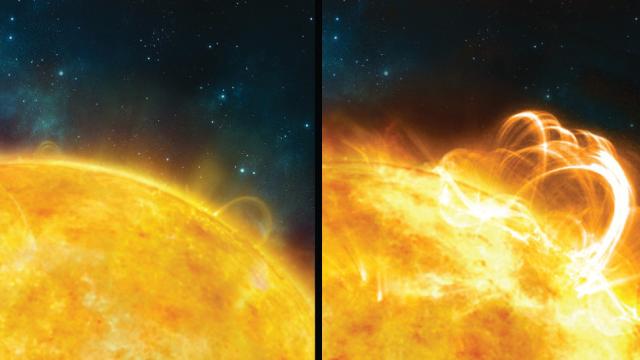By studying a nearby sun-like star, astronomers have concluded that the Sun is capable of releasing solar flares a thousand times greater than anything previously recorded. Scientists say the chances of this are quite slim, but warn that such an event would threaten life on Earth.
Astronomers have documented superflares before, but never in our own Solar System. The new study, conducted by researchers at the University of Warwick, suggests that the similarities between the flares observed on a K-type eclipsing binary star (dubbed KIC9655129) and our own Sun demonstrate the potential for our own host star to produce similar, highly-energetic “superflares”.
The details of their work now appears in the latest edition of The Astrophysical Journal Letters.
Big Bad Stellar Waves
Solar flares are a sudden flash of brightness on a sun’s surface, and they’re among the most powerful forces produced within a stellar system.
A typical solar flare, which happens on our Sun at irregular and frequent intervals, releases energy equal to about 100 million megatonne bombs (or 1029 to 1032 ergs of energy over a timescale of a few hours). But a superflare, which astronomers frequently (and mercifully) observe outside our Solar System, is more powerful by an order of magnitude, releasing energies equivalent to a billion megatonne bombs (or 1033 to 1036 ergs).
If our Sun were to suddenly churn out such a superflare, it would be…bad. Warwick astronomer Chloë Pugh, who led the new study, described it this way in a press release:
If the Sun were to produce a superflare it would be disastrous for life on Earth; our GPS and radio communication systems could be severely disrupted and there could be large scale power blackouts as a result of strong electrical currents being induced in power grids.
It’s obviously important that we learn more about this extreme form of superflare — and whether or not our Sun is actually capable of such stellar feats.
The new study suggest that, yes — our Sun can produce superflares because the underlying physics observed on KIC9655129 also apply to our own Sun. However, the conditions required for a superflare are extremely unlikely to occur on the Sun, a conclusion that’s based on previous observations of solar activity.
Overlapping Super-Pulses
Astronomers are able to study the solar flares of distant stars by scanning the skies for spectral pulses, which resemble waves. Every once in a while, typical solar flares consist of multiple, overlapping pulses. But as the Warwick astronomers note in the new study, their data shows evidence of multiple waves, or multiple periodicities, in a single stellar superflare.

Artist’s impression of a superflare (University of Warwick/Ronald Warmington)
By analysing data collected by the Kepler space telescope, the researchers were able to detect distinct wave patterns in the light curve of a flare emanating from KIC9655129.
Typically, the signatures of a solar flare involve a rapid increase in intensity, followed by a gradual decline. This decline phase is often a bit bumpy, a phenomenon known as “quasi-periodic pulsations,” or QPPs. The flare observed by the Warwick astronomers featured not one, but two significant periodicities. Statistical modelling suggests these two bursts were independent and overlapping — and not the products of chance.
“The most plausible explanation for the presence of two independent periodicities is that the QPPs were caused by magnetohydrodynamic (MHD) oscillations, which are frequently observed in solar flares,” noted study co-author Anne-Marie Broomhall. The magnetic breakdown of stable MHDs, measured as waves and oscillations on the Sun’s corona, are typically cited as cause of solar flares.
This means that the physical processes involved in regular, plain old solar flares (like the ones produced by our Sun), are the same ones that are involved in producing stellar superflares.
“[This] finding supports the hypothesis that the Sun is able to produce a potentially devastating superflare,” concludes Broomhall. So it sounds like our Sun is bigger and badder than we thought possible. Hopefully, we’ll never have an opportunity to see it flex its muscles.
Read the entire study at The Astrophysical Journal Letters: “A Multi-Period Oscillation in a Stellar Superflare“. A free pre-print version can be found here.
